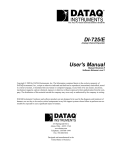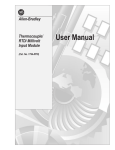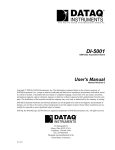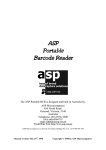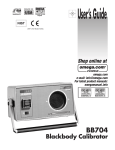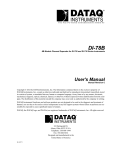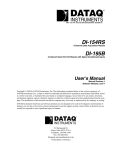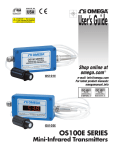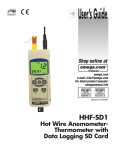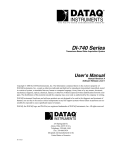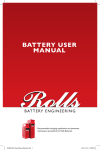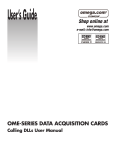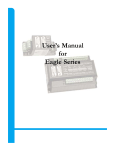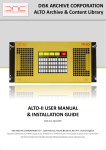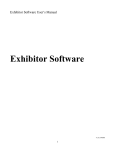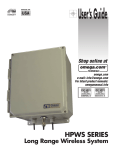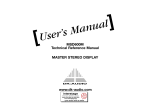Download Industrial Data Acquisition Systems
Transcript
MADE IN User’s Guide Shop online at omega.com e-mail: [email protected] For latest product manuals: omegamanual.info DI-720 SERIES Software-Configurable Recording Instruments DI-730 SERIES Software-Configurable High Voltage Recording Instruments OMEGAnet ® Online Service omega.com Internet e-mail [email protected] Servicing North America: U.S.A.: ISO 9001 Certified Canada: One Omega Drive, P.O. Box 4047 Stamford, CT 06907-0047 TEL: (203) 359-1660 e-mail: [email protected] 976 Bergar Laval (Quebec) H7L 5A1, Canada TEL: (514) 856-6928 e-mail: [email protected] FAX: (203) 359-7700 FAX: (514) 856-6886 For immediate technical or application assistance: U.S.A. and Canada: Sales Service: 1-800-826-6342 / 1-800-TC-OMEGA® Customer Service: 1-800-622-2378 / 1-800-622-BEST® Engineering Service: 1-800-872-9436 / 1-800-USA-WHEN® TELEX: 996404 EASYLINK: 62968934 CABLE: OMEGA Mexico: En Español: (001) 203-359-7803 FAX: (001) 203-359-7807 e-mail: [email protected] [email protected] Servicing Europe: Benelux: Postbus 8034, 1180 LA Amstelveen, The Netherlands TEL: +31 (0)20 3472121 FAX: +31 (0)20 6434643 Toll Free in Benelux: 0800 0993344 e-mail: [email protected] Czech Republic: Frystatska 184, 733 01 Karviná, Czech Republic TEL: +420 (0)59 6311899 FAX: +420 (0)59 6311114 Toll Free: 0800-1-66342 e-mail: [email protected] France: 11, rue Jacques Cartier, 78280 Guyancourt, France TEL: +33 (0)1 61 37 2900 FAX: +33 (0)1 30 57 5427 Toll Free in France: 0800 466 342 e-mail: [email protected] Germany/Austria: Daimlerstrasse 26, D-75392 Deckenpfronn, Germany TEL: +49 (0)7056 9398-0 Toll Free in Germany: 0800 639 7678 e-mail: [email protected] United Kingdom: ISO 9002 Certified FAX: +49 (0)7056 9398-29 One Omega Drive, River Bend Technology Centre Northbank, Irlam, Manchester M44 5BD United Kingdom TEL: +44 (0)161 777 6611 FAX: +44 (0)161 777 6622 Toll Free in United Kingdom: 0800-488-488 e-mail: [email protected] It is the policy of OMEGA Engineering, Inc. to comply with all worldwide safety and EMC/EMI regulations that apply. OMEGA is constantly pursuing certification of its products to the European New Approach Directives. OMEGA will add the CE mark to every appropriate device upon certification. The information contained in this document is believed to be correct, but OMEGA accepts no liability for any errors it contains, and reserves the right to alter specifications without notice. W ARNING: These products are not designed for use in, and should not be used for, human applications. DI-720/DI-730 Series User Manual Table of Contents 1. Introduction ........................................................................................................................................ Features .............................................................................................................................................. Analog Input ...................................................................................................................................... Analog Output ................................................................................................................................... Digital Input and Output (DI-720 Series Only) ................................................................................. 1 1 1 2 2 2. Specifications ...................................................................................................................................... Signal Connections ............................................................................................................................ Interface Characteristics .................................................................................................................... Analog Inputs .................................................................................................................................... Analog Outputs .................................................................................................................................. Digital Input/Output (DI-720 Series Only) ....................................................................................... Timing Input/Output .......................................................................................................................... Input Scan List ................................................................................................................................... Output Scan List ................................................................................................................................ On-board DSP .................................................................................................................................... Physical/Environmental ..................................................................................................................... 3 3 3 3 4 4 4 4 5 5 5 3. Getting Started ................................................................................................................................... Unpacking .......................................................................................................................................... Applying Power to the DI-7x0 Series Instrument ............................................................................. Connecting the DI-7xx Series Instrument to your Computer ............................................................ Parallel (Printer) Port Operation (All Instruments) ..................................................................... Ethernet Operation (DI-720-EN or DI-730-EN Only) ................................................................ USB Operation (DI-720-USB or DI-730-USB Only) ................................................................. Controls and Indicators ...................................................................................................................... DI-720 Series Instrument Front Panel ........................................................................................ DI-730 Series Instrument Front Panel ........................................................................................ Instrument Rear Panel ................................................................................................................. PRINTER PORT .................................................................................................................. STATUS LAMPS ................................................................................................................. POWER INPUT JACK ........................................................................................................ POWER SWITCH ................................................................................................................ ETHERNET PORT .............................................................................................................. RESET SWITCH .................................................................................................................. USB PORT ........................................................................................................................... 7 7 7 8 8 9 9 10 11 13 14 14 14 14 14 15 15 15 4. Calibration Verification ..................................................................................................................... Required Equipment .......................................................................................................................... A/D Calibration (For DI-720 and DI-730 Series Instruments) ................................................... D/A Calibration (DI-720 Instruments Only) ............................................................................... A/D Calibration Verification (DI-720 and DI-730 Series Instruments) ............................................ D/A Calibration (DI-720 Series Only) .............................................................................................. Offset Calibration Verification (DI-720 Series Only) ....................................................................... 17 17 17 17 17 18 19 Table of Contents iii DI-720/DI-730 Series User Manual Full Scale (Span) Calibration Verification (DI-720 Series Only) ..................................................... 19 Offset Calibration Verification (DI-730 Series only) ........................................................................ 20 Full Scale (Span) Calibration Verification (DI-730 Series Only) ..................................................... 20 5. Block Diagram .................................................................................................................................... 21 Table of Contents iv DI-720/DI-730 Series User Manual 1. Introduction Congratulations on your purchase of a DI-720 Series or DI-730 Series data acquisition instrument. These instruments permit data acquisition on IBM personal computers and compatibles from either Windows or the DOS programming environments. This manual describes how to connect and use all of the instruments in the DI-720 and DI-730 Series. Throughout the majority of this manual, enough similarity exists to describe all instruments with the same procedure. The convention used to annotate this similarity is "DI-7x0 Series" (this means that the procedure or information applies equally to the DI-720-P, DI-720-EN, DI-720-USB, DI-730-P, DI-730-EN, or to the DI-730-USB). In cases where the resemblance is not equal, separate procedures/descriptions exist for each instrument. It is assumed that you have a general understanding of data acquisition, digital I/O, and DSP operations, and that you possess enough proficiency in software to write your own application and/or diagnostic programs. Features The DI-7x0 Series provides the following features: • All instruments connect to the parallel port of any desktop, transportable, notebook, or laptop PC-compatible computer. Most communicate through the PC's parallel port in standard, bi-directional, or EPP mode. Models DI720-EN and DI-730-EN only communicate in bi-directional or EPP parallel port modes. Models DI-720-EN, DI730-EN, DI-720-USB, and DI-730-USB add optional Ethernet and USB communication modes respectively. • Per channel software-configurable settings: Single-ended or differential input (DI-720 Series only). Input gain. Sample rate. Signal Averaging. • Flexible power requirements. All instruments operate from any standard 60Hz, 120V AC wall outlet with the supplied power adapter. Or, power the instruments from any +9 to +36 volt DC source, such as a car battery. • 250kHz burst sampling rate. • 16-bit A/D converter, for high resolution measurement accuracy. • 256-entry input list allows you to scan any sequence of input channels at any available gain. The 256-entry input list also allows you to average 32,768 consecutive readings per channel for low-noise output signals. • 256 counters are assigned to the input list allowing each channel to be programmed for a different sample rate. • Supports analog pre- and post-triggering of data acquisition based on the level and slope of a specified channel. The following provides a brief overview of the major subsystems of the DI-7x0 Series. Analog Input 32 single-ended/16 differential analog inputs (on DI-720 Series instruments) or 8 differential analog inputs (on DI730 Series instruments) allow your analog signals to be converted into 16-bit digital data via the onboard A/D converter. The DI-720 Series features software-programmable input measurement ranges of ±10V full scale at a gain of 1; ±5V full scale at a gain of 2; ±2.5V full scale at a gain of 4; and ±1.25V full scale at a gain of 8. The DI-730 Series features software programmable input measurement ranges of ±10mV, ±100mV, ±1V, ±10V, ±100V, and ±1000V full scale (the ±1000V range is useable up to ±800 VDC or peak AC). Introduction 1 DI-720/DI-730 Series User Manual Analog Output On DI-720 instruments, the D/A subsystem features two, buffered, 12-bit D/A converters for outputting analog data. DI-730 instruments have only one 12-bit D/A converter for outputting analog data. Both instruments feature a software-programmable output range of ±10V. Both instruments feature an onboard 16-entry output counter list that allows you to write analog or digital output at the maximum conversion rate of the instrument. Digital Input and Output (DI-720 Series Only) The DI-720 Series contains 8 each input and output lines for input/output operations. These lines provide an interface for the transfer of data between user memory and a peripheral device connected to the instrument. Digital inputs can monitor alarms or sensors with TTL outputs, while digital outputs can drive TTL inputs on control or measurement equipment. Introduction 2 DI-720/DI-730 Series User Manual 2. Specifications Signal Connections Signal connections are made directly to the two, 37-pin, D-type connectors on the front panel of DI-720 Series instruments or to the 5-way binding posts (banana jacks) on the front panel of DI-730 Series instruments. On DI-720 Series instruments, signal connections can also be made with the DI-205, which is an optional, general purpose signal interface that provides convenient, 5-way binding posts (banana jacks) for analog input signals and a screw-terminal strip for digital and analog output signals. Refer to chapter 5 Accessories in this manual for complete DI-205 details. Note that the DI-205 is an extra-cost option that is not included with the purchase of a DI-720 Series instrument. Interface Characteristics Compatible computer architecture: Any PC architecture. Connects to computer via the parallel (or printer) port. Supports standard, bi-directional, or EPP parallel port communication modes (models DI-720-EN and DI-730-EN only support bi-directional and EPP parallel port communication modes). Optional communication interfaces include Ethernet and Universal Serial Bus (USB). Analog Inputs Number of input channels: DI-720 Series: 32 single-ended, 16 differential (software selectable per channel) DI-730 Series: 8 differential Converter resolution: 16-bit Common mode rejection ratio: DI-720 Series: 80 dB minimum @ Av=1 DI-730 Series: 20 dB minimum @ DC to 60Hz Accuracy: ±0.25% of full scale range Crosstalk: -75 dB @ 100kHz and 100W unbalance Sample throughput rate: Printer port: Standard port 40,000; bi-directional port 80,000; EPP 250,000 samples/ second max (software selectable per channel) USB: 200,000 samples/second max Ethernet: 2,000 samples/second max Maximum analog measurement range (software selectable per channel) DI-720 Series: ±10V full scale at a gain of 1 ±5V full scale at a gain of 2 ±2.5V full scale at a gain of 4 ±1.25V full scale at a gain of 8 Specifications 3 DI-720/DI-730 Series User Manual DI-730 Series: ±10mV full scale ±100mV full scale ±1V full scale ±10V full scale ±100V full scale ±1000V full scale (±1000V range useable up to ±800VDC or peak AC) Gain error: 1 bit max @ 1kHz sample rate Input offset voltage: 1 bit max @ 1kHz sample rate Input settling time: 4µs to 0.01% at all gains Input impedance DI-720 Series: MΩ resistor tied to GND on the input channel DI-730 Series: 0 MΩ Analog Outputs Number of channels: DI-720 Series: Two buffered analog outputs DI-730 Series: One analog output Resolution: 12-bit; 1 part in 4,096 @ 250kHz Output voltage range: ±10V full scale Output impedance: 10Ω Sample rate: standard port 40,000; bi-directional port 80,000; EPP 250,000 samples/ second max (software selectable per channel) Output offset voltage: 1 bit max @ 1kHz sample rate Gain error: 1 part in 16,384 @ 1kHz Digital Input/Output (DI-720 Series Only) Capacity: 8 each input and output Compatibility: TTL compatible Max source current: 0.4mA @ 2.4V Max sink current: 8mA @ 0.5V Digital input termination: 4.7kΩ pull-up to +5VDC Timing Input/Output Number of input counters: 256 Number of output counters: 16 Resolution: 1 part in 32,768 Base clock accuracy: 0.01% Counter input frequency: 16 MHz Input Scan List Capacity: 240 elements Specifications 4 DI-720/DI-730 Series User Manual Output Scan List Capacity 16 elements On-board DSP Type: Analog Devices ADSP2181, 32 MIPS Clock frequency: 16 MHz external, 64 MHz internal Data memory: 8k words Program memory: 8k words Physical/Environmental Box dimensions: 7.29"W by 9"L by 1.52"H I/O connector: DI-720 Series: 37-pin male D-type DI-730 Series: Banana jacks Weight: 3 lbs Operating environment: Component temperature: 0º to 70º C Relative humidity: 0% to 90% non condensing Storage environment: Temperature: 55º to 150º C Relative humidity: 0% to 90% non condensing Specifications 5 DI-720/DI-730 Series User Manual Notes: Specifications 6 DI-720/DI-730 Series User Manual 3. Getting Started Unpacking The following items are included with each DI-7x0 Series instrument. Verify that you have the following: • DI-7x0 Series instrument (i.e., DI-720-P, DI-720-EN, DI-720-USB, DI-730-P, DI-730-EN, or DI-730-USB) • Communications cable designed to connect the DI-7x0 Series instrument to your computer's parallel (or printer) port. If you ordered a DI-720-USB or DI-730-USB, you will have a second cable designed to connect the instrument to your computer's USB port. • CD-ROM, "The Software Resource" • DI-720 Series/DI-730 Series User's Manual (which you are currently reading) • WINDAQ Software, in one of two forms: If you ordered WINDAQ /Pro or WINDAQ /Pro+ recording software with your DI-7xx Series instrument (an extracost option), there will be a sticker with a password on the sleeve of your CD-ROM. This password will give you access to that software. If you did not order WINDAQ /Pro or WINDAQ /Pro+ recording software, the WINDAQ/Lite recording software will be available to you without a password. If an item is missing or damaged, call the manufacturer. They will guide you through the appropriate steps for replacing missing or damaged items. Save the original packing material in the unlikely event that your unit must, for any reason, be sent back to the manufacturer. Applying Power to the DI-7x0 Series Instrument Use the following procedure to apply power to your DI-7x0 Series instrument: 1. Plug the five-pin DIN end of the power adapter cable into the five-pin jack labeled POWER on the rear panel of the instrument. Power adapter cable POWER jack Getting Started 7 DI-720/DI-730 Series User Manual 2. Plug one end of the supplied power cord into the power adapter and the other end into any standard 120VAC, 60Hz, single-phase outlet. If an alternate power source is to be used, refer to the following pin-out diagram for power requirements. 3. Turn the POWER switch on. Connecting the DI-7xx Series Instrument to your Computer All DI-7xx Series instruments use your computer’s parallel (or printer) port to interface digital and analog signals to your computer. Optionally, DI-7xx Series instruments with Ethernet or USB communication ports can also be used to interface digital and analog signals to your computer, although not concurrently with the printer port. Parallel (Printer) Port Operation (All Instruments) Plug the appropriate end of the supplied parallel communications cable to the 25-pin male connector labeled PRINTER PORT on the rear panel of the DI-7xx Series instrument and connect the other end of this cable to yourcomputer’s parallel (printer) port. 7xx Series instruments, other parallel port communication modes allow data to pass from the instrument to your computer at higher speeds. Depending on the age of your computer and/or the sophistication of your parallel port, you may have as many as four parallel port communication mode options: standard, bi-directional (PS/2), enhanced parallel port (EPP) and extended capabilities port mode (ECP). DI-7xx Series instruments support the following three parallel port operating modes: Parallel Port Mode Standard Bi-directional (PS/2) EPP (DI-720) EPP (DI-730) Maximum Data Throughput* 40,000 samples/second 80,000 samples/second 250,000 samples/second 150,000 samples/second *This test is done under Windows 98. Getting Started 8 DI-720/DI-730 Series User Manual The parallel port mode you use will depend on how many channels you wish to record and how fast you wish to record them. If, for example, you are only planning to record five channels at 20 Hz each, then standard mode operation will be more than adequate (5 channels × 20 Hz = 100 Hz throughput, which is well within the DI-7xx Series 40KHz standard mode throughput). If, however, you plan to record at a much higher sample rate, for example five channels at 10KHz each, the standard parallel port mode will not reliably record your data gap-free, since this throughput rate exceeds the DI-7xx’s standard mode maximum throughput (5 channels × 10KHz = 50KHz, which is greater than the 40KHz standard mode maximum throughput spec). To reliably record data gap-free at this sample rate, your computer’s parallel port must be operated in something other than standard mode. The only way to change your computer’s parallel port operating mode (if necessary) is to access your computer’s CMOS setup routine. This usually can be accomplished by pressing a certain key (or keys) on your keyboard at the beginning of your computer’s boot-up process. In some cases, a message telling you which key to press is briefly displayed on your monitor at the beginning of the boot-up process. If you do not see such a message, consult your computer documentation for complete CMOS setup routine details. Ethernet Operation (DI-720-EN or DI-730-EN Only) If you have the DI-720-EN or DI-730-EN and you want to use the optional Ethernet communications interface, plug the appropriate end of your Ethernet communications cable into the 10base-T Ethernet port (labeled ETHERNET) on the rear panel of the instrument. Note that you must disconnect the parallel communications cable from the 25-pin male connector labeled PRINTER PORT on the rear panel of the instrument (if connected) in order to use the Ethernet communications interface. Parallel and Ethernet communications cannot be used concurrently. Connect Ethernet communications cable here USB Operation (DI-720-USB or DI-730-USB Only) If you have the DI-720-USB or DI-730-USB and you want to use the optional USB communications interface, you must use Windows 98 or better. 1. With your computer powered, Windows running and all other applications closed, plug the appropriate end of the supplied USB communications cable into the USB port (labeled USB) on the rear panel of the instrument. Connect the other end of this cable to your computer’s USB port. Connect USB cable here Getting Started 9 DI-720/DI-730 Series User Manual The addition of this new hardware will be “sensed” by Windows and the “Add New Hardware Wizard” will automatically be launched, anticipating the installation of a device driver for the new hardware. 2. Insert the WINDAQ Resource CD-ROM into your CD-ROM drive. (The directory on the CD-ROM that contains the appropriate drivers is D:\USB drivers.) 3. From the initial “Add New Hardware Wizard” screen click Next to get started, then choose the search for best driver option (recommended) and click Next. 4. Specify the CD-ROM drive that contains the WINDAQ Resource CD-ROM as the search location and click Next. 5. Follow the onscreen prompts. Depending on how Windows was originally installed on your computer, you may need additional files from your Windows distribution CD-ROM to complete the driver installation. A dialog box will appear indicating the drivers have been found. Click Next to continue. With the driver installation complete, continue with step 6 to install WINDAQ software. Before continuing, makesure the WINDAQ Resource CD-ROM is in your CD-ROM drive. 6. Click the Start button on the taskbar and then click Run… 7. In the text box that appears, type d:setup (where d specifies the drive containing the CD-ROM you inserted in step 2) and press ENTER. A welcome dialog box appears onscreen. 8. Choose the OK button to start the installation. 9. Follow the instructions onscreen to specify the directory where you want to install WINDAQ software. We recommend you accept the default path, but you can name this new directory anything you like. Simply substitute the desired drive and directory in the Destination Directory text box. 10. Choose the OK button. A dialog box is displayed asking if you would like to make backup copies of all files replaced during the installation. This is offered as a safety courtesy; backup copies are not required. Choose the No button if you don’t want to make backups. Choose the Yes button to create backups. If you decide to create backups, you will be prompted to specify a backup file directory. 11. Specify a destination (or group window) for WINDAQ software icons. Again we recommend the default path, but you can specify any group window you like. 12. Enter the ID address of the box. Every DI-720-USB or DI-730-USB is initially assigned an ID address of “0”. If you are adding only one DI-720-USB or DI-730-USB to your system, do nothing. Default ID address “0” will work fine. 13. If you are installing only one DI-720-USB or DI-730-USB on your system, then installation is complete. If you are installing multiple devices, change the Device ID and run through the installation for each device (this does not install multiple versions of the software). Controls and Indicators The following describes the user accessible items on the DI-720 and DI-730 Series instruments. Getting Started 10 DI-720/DI-730 Series User Manual DI-720 Series Instrument Front Panel Connect 16 single-ended or 8 differential inputs directly to each of these connectors. The 37-pin male “D” connector on the left is used to interface analog input channels 1 through 16, eight digital inputs, and eight digital outputs to the DI-720 Series instrument. The analog inputs are labeled CH1 IN through CH16 IN, the digital inputs are labeled DI0 through DI7, and the digital outputs are labeled DO0 through DO7. Other items include DAC2, which is a digital to analog converter that serves as a general-purpose analog output accessible through WINDAQ and SDK software, and two analog grounds labeled AGD. On DI-720 Series instruments with the Ethernet communications option (models DI-720-EN), digital outputs are not available. DI-720 Series instruments can accept 32 high-level or preconditioned analog inputs in single-ended configuration or 16 high-level or preconditioned analog inputs in differential configuration. High-level inputs are typically low impedance, no-conditioning-required signals in the range of ±1.25 to ±10 volts full scale. Single-ended inputs are configured by connecting one signal lead to the desired channel and the other signal lead to analog ground (AGD). Signal Leads Channel 1 configured for single-ended operation Differential inputs occupy two channels (i.e., these channel pairs constitute a differential input: 1 and 9, 2 and 10, 3 and 11, 4 and 12, 5 and 13, 6 and 14, 7 and 15, 8 and 16, etc.), with the lowest numbered channel in the pair assuming the positive (+) input and the channel number. For example, say we have channels 2 and 10 configured as a differen- Getting Started 11 DI-720/DI-730 Series User Manual tial input. Channel 2 is the positive (+) input, channel 10 is the negative (-) input, and the pair is referred to as “channel 2 differential.” - input Signal Leads + input Channel 2 configured for differential operation The 37-pin male “D” connector on the right, labeled EXPANSION, serves a dual purpose. In addition to providing access to analog input channels 17 through 32, this connector also allows you to expand (increase) the total analog input channel capacity of the instrument. Up to 240 channels are possible with the DI-720 Series and expansion instruments. Pinout is as follows: This connector also includes DAC1, which is a second digital-to-analog converter that serves as a general purpose analog output; R. START/STOP, which allows you to remotely start and stop data storage to disk with a switch or TTL level signal; EVNT, which allows you to remotely trigger event markers with a switch or TTL level signal; and two analog grounds labeled AGD. Getting Started 12 DI-720/DI-730 Series User Manual DI-730 Series Instrument Front Panel DI-730 Series instruments can accept any eight differential analog inputs within a range of ±10mV to ±800VDC (or peak AC). Its ±1000V of channel-to-channel and input-to-output isolation protect delicate control circuits, computer equipment, and personnel from high common mode voltages. When optional cable 100679 is plugged into the expansion connector on the rear panel of the DI-730, pinout is as follows: Getting Started 13 DI-720/DI-730 Series User Manual Instrument Rear Panel The rear panel options are the same for DI-720 and DI-730 Series instruments: Instrument Rear Panel EXPANSION +9 to +36 V Common ! 9-36V @3A MAX PRINTER PORT ACTIVE POWER Instrument Rear Panel with Ethernet Option EXPANSION +9 to +36 V Common ! ETHERNET PRINTER PORT 9-36V @3A MAX ACTIVE POWER Instrument Rear Panel with USB Option EXPANSION +9 to +36 V Common ! USB PRINTER PORT ACTIVE 9-36V @3A MAX POWER PRINTER PORT The printer port provides a way to get your input signals into your computer. All DI-720 and DI-730 Series instruments support standard, bi-directional and enhanced (EPP) printer port communication modes except for DI-720-EN models, which only support bi-directional and EPP modes. STATUS LAMPS DI-720 and DI-730 Series instruments provide two status lamps: ACTIVE In DI-7xx-P instruments, this indicator will glow red whenever the instrument is streaming data. This includes all digital input/output (where applicable), analog output and analog input functions. • In DI-7xx-EN instruments, this indicator will glow red whenever data is sent back to the host computer. • In DI-7xx-USB instruments, this indicator will glow when the USB controller is enabled. POWER This indicator glows green when power is applied to the DI-720 or DI-730 Series instrument. POWER INPUT JACK Allows you to apply power to the instrument. Power can be applied with the included power adapter or you can use an alternate source, as long as it is suitable (+9 to +36VDC @ 3A maximum). POWER SWITCH Controls power to the DI-720 or DI-730 Series instrument. 1 is on, 0 is off. Getting Started 14 DI-720/DI-730 Series User Manual ETHERNET PORT In addition to printer port communications, models DI-720-EN and DI-730-EN add Ethernet communication capability with this 10base T port. Note that the Ethernet communication interface cannot be used concurrently with the printer port. RESET SWITCH Models DI-720-EN and DI-730-EN also add a reset switch for resetting Ethernet communications. USB PORT In addition to printer port communications, models DI-720-USB and DI-730-USB add Universal Serial Bus (USB) communication capability with this port. Note that the USB communication interface cannot be used concurrently with the printer port. Getting Started 15 DI-720/DI-730 Series User Manual Notes: Getting Started 16 DI–720/DI-730 Series User Manual 4. Calibration Verification This section provides calibration verification procedures for the A/D and D/A subsystems of the DI-7xx unit. Your instrument is calibrated before it is shipped and, therefore, does not need immediate calibration. Should your unit not comply with the calibration guidelines presented below, arrange to have the manufacturer recalibrate your instrument. Required Equipment A/D Calibration (For DI-720 and DI-730 Series Instruments) • A precision DVM with resolution as a function of the input range being calibrated: minimum DVM resolution = Instrument FSR x 0.1% For example, suppose we have a DI-720-P and we want to calibrate the ±10 volt range (the DI-720 delivers ±10 volts at a gain of 1): 10V x 0.1% = 10mV So we would need a DVM with a resolution of 10V or more to calibrate the ±10 volt range. • A stable voltage source with a stability specification equal to or greater than the minimum DVM resolution, as calculated above, required to calibrate the instrument at the highest desired gain. OR • An alternative is to use a voltage calibrator with enough resolution, as calculated above, to calibrate the instrument at the highest desired gain. D/A Calibration (DI-720 Instruments Only) • A precision DVM with resolution of at least 1 mv. A/D Calibration Verification (DI-720 and DI-730 Series Instruments) Calibration verification of DI-720 Series instruments' A/D subsystem is performed on channel 1, with all other channels returned to analog common. Calibration of DI-730 Series instrument's A/D subsystem is performed on a channel-by-channel basis for the 8 wide range inputs and on channel 17 for the general-purpose channels. The following figures illustrate the necessary connections: Calibration Verification 17 DI–720/DI-730 Series User Manual + DVM Voltage Source + + CH 1 CH 2 CH 3 CH 4 CH 5 CH 6 CH 7 CH 8 CH 9 CH 30 CH 31 CH 32 S. GND (signal ground) DI-720 Series Instruments and 16 DI-730 General-Purpose Channels + + + CH 1 CH 2 CH 3 + CH 8 + Voltage Source DVM DI-730 Series 8 Wide-Range Channels Or if you are using the alternative voltage calibrator, the following figure illustrates the necessary connections: + Voltage Calibrator + CH 1 CH 2 CH 3 CH 4 CH 5 CH 6 CH 7 CH 8 CH 9 CH 30 CH 31 CH 32 S. GND (signal ground) DI-720 Series Instruments and 16 DI-730 General-Purpose Channels + + + CH 1 CH 2 CH 3 CH 8 + Voltage Calibrator DI-730 Series 8 Wide-Range Channels D/A Calibration (DI-720 Series Only) D/A calibration involves adjusting the analog outputs to the correct full-scale range using the analog data value. The following figure illustrates the necessary connections: Calibration Verification 18 DI–720/DI-730 Series User Manual When the above circuit is connected, the calibration program can be initiated by typing “DI720CAL” at the DOS prompt. D/A calibration is accomplished by following the on screen prompts. Offset Calibration Verification (DI-720 Series Only) 1. Connect your voltage calibrator, or combination DVM and voltage source to your DI-7XX instrument as shown above. Apply zero volts to the instrument (or short the instrument's analog channel input to ground). 2. Open the WINDAQ/Lite/Pro/Pro+ data acquisition screen. Enable the channel you will use to quantify offset. Since all channels are adjusted together, any channel may be selected. Enable a maximum burst sample rate of 50,000 Hz by selecting EDIT-PREFERENCES-MAX SAMPLE RATE. Enable a WINDAQ sample rate of 50 Hz. Set the Acquisition Mode to AVERAGE and the gain factor to 1 through WINDAQ’s CHANNEL SETTINGS menu for the selected channel. 3. Referring to WINDAQ software's voltage display for the channel you're evaluating, compare this value to that given in the OFFSET column of TABLE (1) for the selected gain factor. 4. Repeat steps 2 and 3 using a gain of 2, 4 and 8 for the selected channel. 5. If any readings are out of the acceptable ranges described in TABLE (1) arrange to have your instrument recalibrated by the manufacturer. Full Scale (Span) Calibration Verification (DI-720 Series Only) 1. Referring again to TABLE (1) set the instrument's gain to 1 and apply the voltage indicated by the SPAN VOLTAGE column of TABLE (1) to the selected channel. Note that since all channels are calibrated together, any channel may be selected. 2. Verify the reading by comparing the value displayed by WINDAQ software with the value of TABLE (1) in the SPAN ACCURACY column. 3. Repeat for gain selections of 2, 4, and 8. 4. If any readings are out of the acceptable ranges described in TABLE (1) arrange to have your instrument recalibrated by the manufacturer.. TABLE 1 Gain Factor 1 2 4 8 Offset @ 0V 0V ±20mV 0V ±10mV 0V ±5mV 0V ±5mV Span Voltage 9.800V 4.900V 2.400V 1.200V Span Accuracy* 9.800V ±25mV 4.900V ±12.5mV 2.400V ±6.25mV 1.200 ±3.125mV * Excludes offset errors. TABLE 2 (Only applicable for DI-722 differential channels) Gain Factor 1 2 4 8 Offset @ 0V 0V ±40mV 0V ±20mV 0V ±10mV 0V ±10mV Span Voltage 19.600V 9.800V 4.800V 2.400V Calibration Verification 19 Span Accuracy* 19.600V ±50mV 9.800V ±25mV 4.800V ±12.5mV 2.400 ±6.25mV * Excludes offset errors DI–720/DI-730 Series User Manual Offset Calibration Verification (DI-730 Series only) 1. Connect your voltage calibrator, or combination DVM and voltage source to your DI-730 instrument as shown above. Apply zero volts to the instrument (or short the instrument's analog channel input to ground). 2. Open the WINDAQ/Lite/Pro/Pro+ data acquisition screen. Enable the channel you want to verify. Enable a maximum burst sample rate of 50,000 Hz by selecting EDIT-PREFERENCES-MAX SAMPLE RATE. Enable a WINDAQ sample rate of 50 Hz. Set the Acquisition Mode to AVERAGE select the 10mV range through WINDAQ's CHANNEL SETTINGS menu for the selected channel. 3. Referring to WINDAQ software's voltage display for the channel you're evaluating, compare this value to that given in the OFFSET column of TABLE (2) for the selected range. 4. Repeat steps 2 and 3 using for each measurement range. 5. Select the next channel, and repeat steps 2 through 4. 6. If any readings are out of the acceptable ranges described in TABLE (2) arrange to have your instrument recalibrated by the manufacturer. Full Scale (Span) Calibration Verification (DI-730 Series Only) 1. Referring again to TABLE (2) select the 10mV range and apply the voltage indicated by the SPAN VOLTAGE column of TABLE (2) to the selected channel. 2. Verify the reading by comparing the value displayed by WINDAQ software with the value of TABLE (2) in the SPAN ACCURACY column. 3. Repeat steps 1 and 2 for all ranges. 4. Repeat steps 1 through 3 for all channels. 5. If any readings are out of the acceptable ranges described in TABLE (1) arrange to have your instrument recalibrated by the manufacturer. TABLE (2) Channel Group Range Offset @ 0V Span Voltage Span Accuracy* 1 through 8 10mV 0 ±0.04mV 9mV 9mV ±0.025mV** 100mV 0 ±0.4mV 90mV 90mV ±0.25mV** 1V 0 ±4mV 900mV 900mV ±2.5mV 10V 0 ±10mV 9V 9V ±25mV 100V 0 ±100mV 90V 90V ±250mV 1000V 0 ±1V 700V 700V ±2V 17 through 32 10V 0 ±5mV 9V 9V ±25mV 5V 0 ±3mV 4.5V 4.5V ±12.5mV 2.5V 0 ±2mV 2V 2V ±6.25mV 1.25V 0 ±1mV 1V 1V ±3.125mV *Excludes offset errors. ** These low-level measurements require an environment free from electrical noise. Calibration Verification 20 DI–720/DI-730 Series User Manual 5. Block Diagram ANALOG OUT 1 1 PGA ADC/DAC DIG OUT PORT 16 MHz ANALOG IN DIGITAL OUT 16 1 MUX TIMER DIG IN PORT DSP DIGITAL IN 16 PROGRAM RAM 8K WORDS 32 DATA RAM 8K WORDS PARALLEL INTERFACE ETHERNET INTERFACE PARALLEL PORT ETHERNET PORT Block Diagram 21 EE PROM USB INTERFACE USB PORT DI–720/DI-730 Series User Manual Notes: Block Diagram 22 WARRANTY/DISCLAIMER OMEGA ENGINEERING, INC. warrants this unit to be free of defects in materials and workmanship for a period of 13 months from date of purchase. OMEGA’s WARRANTY adds an additional one (1) month grace period to the normal one (1) year product warranty to cover handling and shipping time. This ensures that OMEGA’s customers receive maximum coverage on each product. If the unit malfunctions, it must be returned to the factory for evaluation. OMEGA’s Customer Service Department will issue an Authorized Return (AR) number immediately upon phone or written request. Upon examination by OMEGA, if the unit is found to be defective, it will be repaired or replaced at no charge. OMEGA’s WARRANTY does not apply to defects resulting from any action of the purchaser, including but not limited to mishandling, improper interfacing, operation outside of design limits, improper repair, or unauthorized modification. This WARRANTY is VOID if the unit shows evidence of having been tampered with or shows evidence of having been damaged as a result of excessive corrosion; or current, heat, moisture or vibration; improper specification; misapplication; misuse or other operating conditions outside of OMEGA’s control. Components in which wear is not warranted, include but are not limited to contact points, fuses, and triacs. OMEGA is pleased to offer suggestions on the use of its various products. However, OMEGA neither assumes responsibility for any omissions or errors nor assumes liability for any damages that result from the use of its products in accordance with information provided by OMEGA, either verbal or written. OMEGA warrants only that the parts manufactured by the company will be as specified and free of defects. OMEGA MAKES NO OTHER WARRANTIES OR REPRESENTATIONS OF ANY KIND WHATSOEVER, EXPRESSED OR IMPLIED, EXCEPT THAT OF TITLE, AND ALL IMPLIED WARRANTIES INCLUDING ANY WARRANTY OF MERCHANTABILITY AND FITNESS FOR A PARTICULAR PURPOSE ARE HEREBY DISCLAIMED. LIMITATION OF LIABILITY: The remedies of purchaser set forth herein are exclusive, and the total liability of OMEGA with respect to this order, whether based on contract, warranty, negligence, indemnification, strict liability or otherwise, shall not exceed the purchase price of the component upon which liability is based. In no event shall OMEGA be liable for consequential, incidental or special damages. CONDITIONS: Equipment sold by OMEGA is not intended to be used, nor shall it be used: (1) as a “Basic Component” under 10 CFR 21 (NRC), used in or with any nuclear installation or activity; or (2) in medical applications or used on humans. Should any Product(s) be used in or with any nuclear installation or activity, medical application, used on humans, or misused in any way, OMEGA assumes no responsibility as set forth in our basic WARRANTY/DISCLAIMER language, and, additionally, purchaser will indemnify OMEGA and hold OMEGA harmless from any liability or damage whatsoever arising out of the use of the Product(s) in such a manner. RETURN REQUESTS/INQUIRIES Direct all warranty and repair requests/inquiries to the OMEGA Customer Service Department. BEFORE RETURNING ANY PRODUCT(S) TO OMEGA, PURCHASER MUST OBTAIN AN AUTHORIZED RETURN (AR) NUMBER FROM OMEGA’S CUSTOMER SERVICE DEPARTMENT (IN ORDER TO AVOID PROCESSING DELAYS). The assigned AR number should then be marked on the outside of the return package and on any correspondence. The purchaser is responsible for shipping charges, freight, insurance and proper packaging to prevent breakage in transit. FOR WARRANTY RETURNS, please have the following information available BEFORE contacting OMEGA: 1. Purchase Order number under which the product was PURCHASED, 2. Model and serial number of the product under warranty, and 3. Repair instructions and/or specific problems relative to the product. FOR NON-WARRANTY REPAIRS, consult OMEGA for current repair charges. Have the following information available BEFORE contacting OMEGA: 1. Purchase Order number to cover the COST of the repair, 2. Model and serial number of the product, and 3. Repair instructions and/or specific problems relative to the product. OMEGA’s policy is to make running changes, not model changes, whenever an improvement is possible. This affords our customers the latest in technology and engineering. OMEGA is a registered trademark of OMEGA ENGINEERING, INC. © Copyright 2004 OMEGA ENGINEERING, INC. All rights reserved. This document may not be copied, photocopied, reproduced, translated, or reduced to any electronic medium or machine-readable form, in whole or in part, without the prior written consent of OMEGA ENGINEERING, INC. Where Do I Find Everything I Need for Process Measurement and Control? OMEGA…Of Course! Shop online at omega.com TEMPERATURE Thermocouple, RTD & Thermistor Probes, Connectors, Panels & Assemblies Wire: Thermocouple, RTD & Thermistor Calibrators & Ice Point References Recorders, Controllers & Process Monitors Infrared Pyrometers PRESSURE, STRAIN AND FORCE Transducers & Strain Gages Load Cells & Pressure Gages Displacement Transducers Instrumentation & Accessories FLOW/LEVEL Rotameters, Gas Mass Flowmeters & Flow Computers Air Velocity Indicators Turbine/Paddlewheel Systems Totalizers & Batch Controllers pH/CONDUCTIVITY pH Electrodes, Testers & Accessories Benchtop/Laboratory Meters Controllers, Calibrators, Simulators & Pumps Industrial pH & Conductivity Equipment DATA ACQUISITION Data Acquisition & Engineering Software Communications-Based Acquisition Systems Plug-in Cards for Apple, IBM & Compatibles Datalogging Systems Recorders, Printers & Plotters HEATERS Heating Cable Cartridge & Strip Heaters Immersion & Band Heaters Flexible Heaters Laboratory Heaters ENVIRONMENTAL MONITORING AND CONTROL Metering & Control Instrumentation Refractometers Pumps & Tubing Air, Soil & Water Monitors Industrial Water & Wastewater Treatment pH, Conductivity & Dissolved Oxygen Instruments M3531/1004




























